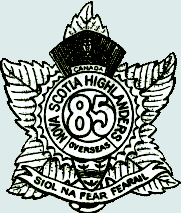Related Research Articles

The No. 2 Construction Battalion, Canadian Expeditionary Force (CEF), was raised in Nova Scotia and was one of two predominantly black battalions in Canadian military history and the only Canadian battalion composed of black soldiers to serve in World War I. Commanded by Lieutenant Colonel Daniel Hugh Sutherland, formerly of the 193rd Battalion, CEF, all but one of the unit's 19 officers were white, the exception being Captain William A. White, the unit's chaplain.

The 5th Canadian Division is a formation of the Canadian Army responsible for the command and mobilization of most army units in the provinces of New Brunswick, Nova Scotia, Prince Edward Island and Newfoundland and Labrador; as well as some units in Kingston, Ontario. The division is recognized by the distinctive maroon patch worn on the sleeve of its soldiers.

The Nova Scotia Highlanders is an infantry regiment in the primary reserve of the Canadian Army. It is part of 36 Canadian Brigade Group, 5th Canadian Division.

The North Nova Scotia Highlanders was an infantry regiment of the Canadian Army founded in 1936. In 1954, it was amalgamated with The Pictou Highlanders and 189 LAA RCA Battery to form 1st Battalion, The Nova Scotia Highlanders (North).
The Pictou Highlanders was an infantry regiment of the Canadian Army from 1871 until it was amalgamated into The Nova Scotia Highlanders in 1954.
The 185th Battalion, CEF was a unit in the Canadian Expeditionary Force during the First World War.

The 207th (Carleton) Battalion, CEF was a battalion of the First World War Canadian Expeditionary Force.
The 219th (Highland) Battalion, CEF was a unit in the Canadian Expeditionary Force during the First World War.

The 84th Regiment of Foot was a British regiment in the American Revolutionary War that was raised to defend present day Ontario, Quebec and Atlantic Canada from the constant land and sea attacks by American Revolutionaries. The 84th Regiment was also involved in offensive action in the Thirteen Colonies; including North Carolina, South Carolina, Georgia, Virginia and what is now Maine, as well as raids upon Lake Champlain and the Mohawk Valley. The regiment consisted of 2,000 men in twenty companies. The 84th Regiment was raised from Scottish soldiers who had served in the Seven Years' War and stayed in North America. As a result, the 84th Regiment had one of the oldest and most experienced officer corps of any regiment in North America. The Scottish Highland regiments were a key element of the British Army in the American Revolution. The 84th Regiment was clothed, armed and accoutred the same as the Black Watch, with Lieutenant Colonel Allan Maclean commanding the first battalion and Major General John Small of Strathardle commanding the second. The two Battalions operated independently of each other and saw little action together.

A Scottish regiment is any regiment that at some time in its history has or had a name that referred to Scotland or some part thereof, and adopted items of Scottish dress. These regiments were created after the Acts of Union in 1707 between England and Scotland, either directly serving Britain during its various wars, or as part of the military establishments of Commonwealth countries. Their "Scottishness" is no longer necessarily due to recruitment in Scotland nor any proportion of members of Scottish ancestry.
The 106th Battalion, CEF was a unit in the Canadian Expeditionary Force during the First World War. Based in Truro, Nova Scotia, with two additional companies in Pictou and Springhill, the unit began recruiting on 18 November 1915. The battalion was the first rifle regiment in Maritime Canada. The battalion sailed to England on 16 July 1916 and trained at Lower Dibgate, Shorncliffe. It was later broken up and most members were absorbed into the 40th Battalion, CEF.
The 246th Battalion, CEF was a unit in the Canadian Expeditionary Force during the First World War. Based in Halifax, Nova Scotia, the unit began recruiting in the summer of 1916 throughout the province of Nova Scotia. The unit sent two drafts to England in April and June 1917, both of which were absorbed into the 17th Reserve Battalion, CEF upon arrival. The 246th Battalion, CEF had one Officer Commanding: Lieut-Col. N. H. Parsons.

The 85th Battalion, CEF, was an infantry battalion of the Canadian Expeditionary Force during the Great War. The 85th Battalion was authorized on 14 September 1915 and embarked for Great Britain on 12 October 1916. Disembarking in France in February 1917, it fought as part of the 12th Infantry Brigade, 4th Canadian Division in France and Flanders until the end of the war. The battalion is most famous for capturing Hill 145 in their first battle. Today, the Vimy Memorial stands on Hill 145.

The Regimental Pipes and Drums of The Calgary Highlanders is an authorized volunteer pipe band associated with The Calgary Highlanders of the Canadian Forces. For many years, the band was a bona fide, and separate, military unit unto itself, with a separate Unit Identification Code within the CF. Today, the band has been reduced to volunteer status but officially maintains an establishment of eight paid military musicians on its rolls. The band has had mixed success in competitions, but under the direction of Pipe Major Michael Giles had become successful in the Grade Three circuit in Alberta in the years leading up to the regimental centennial in 2010. The band published a recording to commemorate the 80th anniversary of the Regiment in 1990, titled Eighty Years of Glory and commemorated its centennial in 2010 by releasing a second CD entitled Onward.

Atlantic Command was a formation of the Canadian Army created during the Second World War to strengthen and administer home defence facilities on Canada's Atlantic Coast. A second major function was to train reinforcements to be sent to the Canadian divisions in Europe. Most of those soldiers received and trained with their personal weapons in Camp Debert before being transported by train to Halifax where they embarked on troop ships that took them to Britain.
193rd may refer to:

The 25th Battalion, CEF was a unit in the Canadian Expeditionary Force during the Great War. It was the second infantry battalion of ten to be raised in Nova Scotia during the war. The 25th served in Belgium and France as part of the 5th Canadian Brigade, 2nd Canadian Division from 16 September 1915 until the end of the war. Regimental headquarters were established at the Halifax Armouries, with recruitment offices in Sydney, Amherst, New Glasgow, Truro and Yarmouth. Of the 1000 Nova Scotians that started with the battalion, after the first year of fighting, 100 were left in the battalion, while 900 men were killed, taken prisoner, missing or injured.
The 17th Battalion, CEF was a battalion of the Canadian Expeditionary Force during the Great War.

The 113th Battalion, CEF, was an infantry battalion of the Great War Canadian Expeditionary Force. The 113th Battalion was authorized on 22 December 1915 as part of a recruiting drive in which men from the same region could enlist and serve together.
The Cumberland Highlanders was an infantry regiment of the Non-Permanent Active Militia of the Canadian Militia. In 1936, the regiment was Amalgamated with The Colchester and Hants Regiment to form The North Nova Scotia Highlanders.
References
- ↑ Anonymous, Prominent People of the Maritime Provinces [in business and professional life], Montreal: Canadian Publicity Company, 1922, p. 206.
- Meek, John F. Over the Top! The Canadian Infantry in the First World War. Orangeville, Ont.: The Author, 1971.